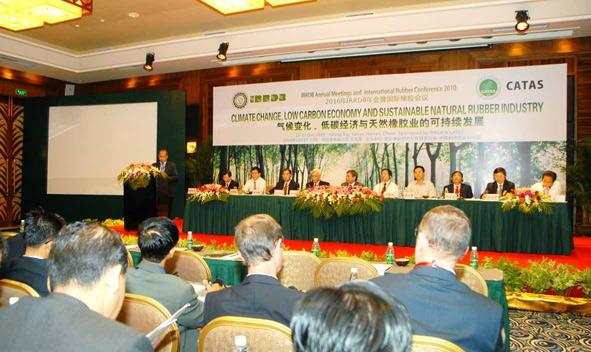Source: Chinese Academy of Tropical Agricultural Sciences

Opening Ceremony
As the highest-level, most inclusive and most influential international meeting in the world natural rubber academia, the Annual Meeting of International Rubber Research and Development Board (IRRDB) and the International Rubber Conference 2010 sponsored by the Chinese Academy of Tropical Agricultural Sciences (CATAS) and IRRDB was held in Yalongwan, Sanya on Oct. 18-22.
This meeting attracted nearly 400 participants from 15 major member countries and associate members of IRRDB, the International Rubber Study Group (IRSG), the Association of Natural Rubber Producing Countries (ANRPC) and some other organizations. Under the theme of Climate Change, Low Carbon Economy and Sustainable Natural Rubber Industry, the participants conducted academic exchange on seven topics, i.e. selection and breeding of rubber, physiology of rubber tapping, cultivation and environment, pest and disease management, biotechnology, product processing and economic management of rubber plantations.
Datuk Dr Abdul Aziz B S A Kadir, Secretary General of IRRDB, said at the opening ceremony given that the natural rubber output of IRRDB member countries accounted for 99% of the world s total and the industries related to natural rubber across the globe would be hit in case of any climate change impact on the natural rubber production of the IRRDB member countries, it was important for all the member countries and even the world to seriously cope with the impact of climate change on the natural rubber industry. Meanwhile, it was necessary to utilize the carbon sequestration function of rubber plantations and strive for benefits from the Clean Development Mechanism (CDM) and trade. It was also noted that the number of participants from aboard in this meeting was highest in the 50 years history of IRRDB.
During the academic discussion about the three keynote presentations and seven specialized topics, experts and scholars shared views on how the natural rubber industry could respond to global climate change, enable rubber trees to perform the carbon sequestration function and reduce greenhouse gas emissions from production and processing processes and the input of fossil energy and materials in other processes, so as to develop itself into a real low-carbon green industry, make itself adapted to global climate change and make its own contribution to the mitigation efforts.
(Date: 16:55 26 Oct. 2010)
Related News
Photos
More>>trade
- Vice Minister Niu Dun meets with leaving Argentine Ambassador to China
- China waters 1 million hectares of arid farmland
- National work conference on farmers sport associations 2011
- Ministry of Agriculture and China Development Bank sign Memorandum on Planning
- Vice Minister Niu Dun meets with USDA Under Secretary Catherine Woteki
market
- Special Program on Spring Ploughing 2011 launched in Hainan
- Memorandum of Understanding on Cooperation between the Ministry of Agriculture
- Government agencies join hands to promote agri-tourism
- China may face more inflation pressure in 2011: Analyst
- GM says happy with SAIC's participation in its IPO





